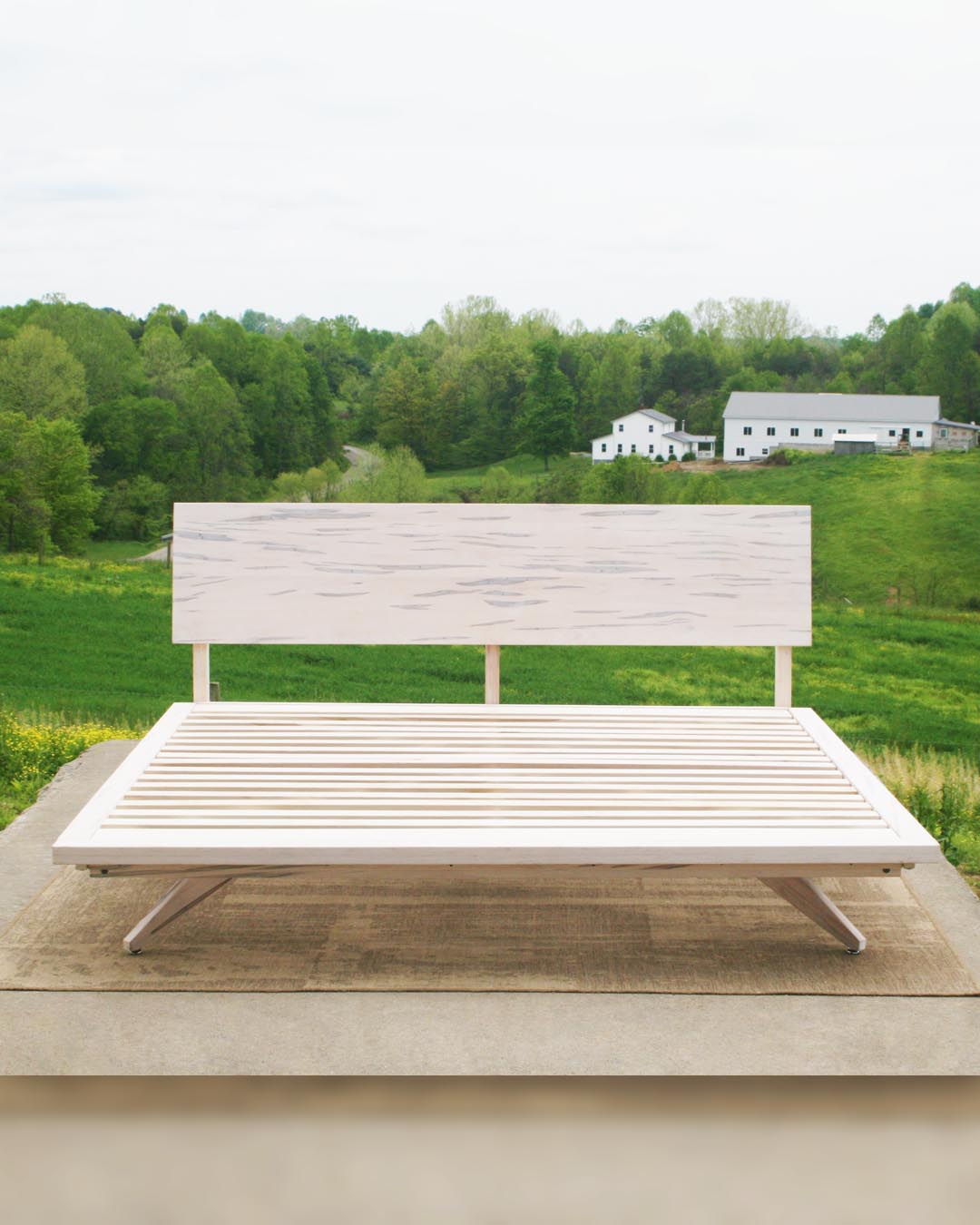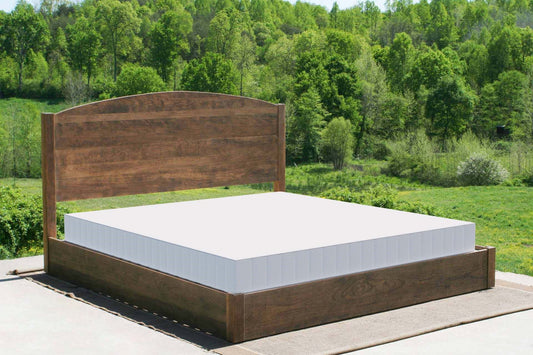Does All Furniture Expose You To Formaldehyde?
Matt Solid
Is there Formaldehyde in my bed?
While formaldehyde exposure from furniture is a valid indoor air quality concern, the answer is reassuring: not all furniture exposes you to formaldehyde. The primary culprit behind formaldehyde emissions in homes is furniture made from composite wood products—such as particle board, MDF, and plywood—due to the resins and adhesives used in their manufacture. In contrast, high-quality solid wood furniture, like that offered by Solid Custom Heirlooms, naturally contains no added formaldehyde and remains an exceptionally healthy and safe choice for homeowners and interior designers.
Does all furniture contain formaldehyde?
Not all furniture contains or releases formaldehyde. The main differentiator lies in the materials and manufacturing processes used. Composite wood products—that is, furniture made from engineered materials such as particle board, medium-density fiberboard (MDF), and plywood—often use adhesives containing urea-formaldehyde resins. These adhesives slowly release (or off-gas) formaldehyde over time, potentially impacting indoor air quality and occupant health. However, furniture crafted from solid wood, like cherry, walnut, oak, or maple, generally does not contain these added chemicals.
What are the main sources of formaldehyde in furniture?
The most common sources of formaldehyde in furniture are composite woods and certain finishes. These include pressed wood (particle board and MDF), plywoods, and sometimes upholstered furniture where engineered wood is used for framing. Even some paints, finishes, and adhesives can contribute to formaldehyde exposure, especially if they haven’t been specifically formulated for low emissions. On the other hand, solid wood furniture—when finished with natural oils like the Tung Oil used by Solid Custom Heirlooms—produces negligible emissions and offers a healthier solution for homes and design projects.
Is everyone exposed to formaldehyde at home?
Formaldehyde exposure in modern homes is common but not inevitable. Homes furnished with several pieces made from pressed wood products and conventional finishes are more likely to have higher formaldehyde concentrations, especially in newer or poorly ventilated spaces. However, those choosing solid wood furniture—particularly pieces manufactured with low- or zero-VOC finishes—noticeably reduce their family’s exposure. For highly sensitive individuals or clients, selecting products from reputable makers like Solid Custom Heirlooms can make all the difference in creating a safer, healthier indoor environment.
Where is formaldehyde exposure most likely to occur in the home?
Formaldehyde exposure is most likely to occur in rooms furnished with new, mass-produced items made from composite woods—living rooms, bedrooms, and offices outfitted with particle board bookcases, MDF bed frames, or plywood desks are prime candidates. Children’s furniture and budget-friendly home office pieces often use these materials to keep costs low. In contrast, investing in solid wood furniture significantly lowers the risk of exposure. Solid Custom Heirlooms specializes in authentic American hardwood pieces, delivering beauty, durability, and peace of mind without the hidden chemical risks found in cheaper, mass-produced imports.
Solid Custom Heirlooms: Your Formaldehyde-Free Furniture Solution
For homeowners and interior designers seeking to balance style, sustainability, and indoor air safety, Solid Custom Heirlooms provides a proven alternative. Our furniture is meticulously hand-crafted from premium American hardwoods, sourced responsibly, and finished with natural Tung Oil for exceptionally low VOC emissions. Choosing solid wood furniture from a reputable local maker is one of the most effective ways to foster a healthy and beautiful home environment, free from unnecessary exposure to formaldehyde and other chemicals.
Which Kinds Of Furniture Are Most Likely To Release Formaldehyde?
Not all furniture poses equal risks when it comes to formaldehyde exposure. The primary culprits for releasing significant amounts of this chemical are pieces made with composite wood products, such as particle board, medium-density fiberboard (MDF), and plywood. These engineered woods rely on adhesives—most notably urea-formaldehyde resins—that can emit volatile organic compounds (VOCs), including formaldehyde, into your indoor air. By contrast, solid wood furniture made by reputable makers like Solid Custom Heirlooms avoids these adhesives and thereby minimizes off-gassing, contributing to a safer and healthier home environment.
Which kinds of furniture are most likely to release formaldehyde?
Furniture made from pressed or engineered wood is far more likely to emit formaldehyde than furniture crafted from solid hardwoods. Particle board, MDF, and plywood—the backbone of most inexpensive, mass-produced furniture—are manufactured by binding wood particles or fibers together with formaldehyde-based adhesives. Over time, these adhesives can break down and release formaldehyde fumes into the air, a process known as furniture off-gassing. Items like low-cost dressers, bookshelves, cabinets, dining tables, and even upholstered furniture with hidden composite cores are particularly suspect. Mass retailers and imported furniture, especially those not explicitly labeled as low-emission or formaldehyde-free, commonly feature these high-risk materials.
On the other hand, solid wood furniture, while potentially coated with some type of finish, naturally contains little to no formaldehyde. The absence of high-emitting adhesives and particle board in their structure makes them an excellent choice for those looking to reduce chemical exposure. Solid Custom Heirlooms, for instance, exclusively uses American hardwood and natural oil finishes, further reducing the already minimal VOC emissions found with solid wood pieces.
How can you tell if furniture contains formaldehyde?
The easiest way to identify high-risk pieces is by closely examining materials and product information. Look for terms like "particle board," "MDF," or "plywood" in product descriptions, as these signal composite wood construction. Labels may sometimes reference CARB (California Air Resources Board) or TSCA Title VI compliance—standards set to reduce, but not eliminate, formaldehyde emissions. If no information is available or the furniture has a strong chemical smell, off-gassing is likely occurring. Further, manufacturers of low formaldehyde furniture or solid hardwood options will often highlight their VOC-free status, use of real wood, and absence of chemical-laden adhesives. Reputable American furniture makers such as Solid Custom Heirlooms offer transparency about their wood sources and finishing techniques, helping assure clients of a healthier, safer product. Homeowners and interior designers should prioritize these details when searching for furnishings with minimal off-gassing risks.
What role do finishes and upholstery play in formaldehyde emissions?
While the core structure is the leading factor in emissions, finishes and upholstery can also contribute to indoor VOC levels. Many mass-produced finishes (like certain paints, lacquers, and synthetic adhesives) release VOCs, including formaldehyde, particularly when freshly applied. Upholstered furniture may also use foam cushions or glues that further elevate emission levels. Opting for natural oil finishes—such as the tung oil used by Solid Custom Heirlooms—or explicitly low-VOC products can drastically reduce overall emissions. In short, for the healthiest options, choose solid wood furniture finished and upholstered with natural, low-emission products.
Tips for identifying high-risk furniture
Always read product specifications carefully: look for clear statements about material composition and finishes used. Ask manufacturers for documentation on formaldehyde emission standards compliance, such as CARB Phase 2 or TSCA Title VI. Choose local or American-made solid wood pieces where the wood grain is visible and continuous across edges, indicating real wood rather than veneer over composite core. If possible, visit showrooms or request wood samples—solid wood typically has a natural aroma and feel, while composite-based products may have a chemical odor and uniform, synthetic appearance. By prioritizing these factors, you can select low formaldehyde furniture that supports both your health and design vision.
Is Formaldehyde In Furniture Dangerous?
Formaldehyde is a colorless, strong-smelling chemical commonly used in the manufacturing of composite wood products such as particle board, MDF, and plywood, as well as certain adhesives and finishes on furniture. Exposure to formaldehyde from furniture can be hazardous, particularly in poorly ventilated spaces. Health concerns range from short-term irritation to long-term increased cancer risk, making it crucial for homeowners and interior designers to understand where formaldehyde comes from and how it impacts indoor air quality.
Is formaldehyde in furniture dangerous?
Yes, formaldehyde in furniture can pose health risks, especially with high or prolonged exposure. Short-term effects often manifest as eye, nose, and throat irritation, headaches, or respiratory discomfort. Over time, chronic exposure—especially in environments with limited fresh air or abundant composite wood products—can lead to more serious health risks, such as exacerbation of asthma, allergic reactions, and in rare cases, increased risk of certain cancers. The risk is higher in homes filled with imported particle board or veneer furniture, which can emit higher levels of formaldehyde for months or even years after purchase.
What are the health symptoms of exposure to formaldehyde from furniture?
Symptoms of formaldehyde exposure can vary from person to person and depend on the concentration in the air. Common acute symptoms include burning or watery eyes, runny nose, coughing, sore throat, skin rashes, headaches, and a general feeling of discomfort. With chronic exposure, especially in sensitive populations like children, the elderly, or those with asthma or allergies, formaldehyde health risks can escalate to persistent respiratory symptoms, increased frequency or severity of asthma attacks, and in rare scenarios, neurological effects. The International Agency for Research on Cancer (IARC) classifies formaldehyde as “carcinogenic to humans,” with long-term exposure linked to certain types of cancer, including nasopharyngeal cancer and leukemia.
How long does it take for formaldehyde to cause cancer?
Cancer risk from formaldehyde exposure depends on the concentration and duration of exposure. Minimal, infrequent interactions with low-emitting furniture are unlikely to cause significant harm for most individuals. However, studies suggest that living in environments with consistently elevated levels of formaldehyde (such as homes densely furnished with non-compliant pressed wood products) over several years can increase the risk of developing cancer. The latency period (the time it takes for cancer to develop following exposure) varies widely but is often measured in years or even decades. While there is no precise threshold or timeline, minimizing exposure—especially for vulnerable populations—remains a prudent choice.
Who is most vulnerable to formaldehyde exposure?
While anyone can be affected by elevated formaldehyde levels, certain groups are more susceptible. Children and infants, with their developing respiratory systems, are particularly at risk, as are elderly adults and individuals with pre-existing respiratory conditions such as asthma or chronic obstructive pulmonary disease (COPD). Pregnant women may also want to take extra precautions to limit indoor air pollution, including formaldehyde exposure, during pregnancy. For all individuals, improving indoor air quality by choosing safe, solid wood furniture and ensuring good ventilation is essential.
How can Solid Custom Heirlooms help you avoid health risks from formaldehyde?
Unlike mass-produced furniture which often relies on pressed wood and high-emitting adhesives, Solid Custom Heirlooms crafts each piece from genuine American hardwoods—such as Cherry, Maple, Walnut, Oak, and Ash—which do not emit harmful VOCs or formaldehyde. Finishes are carefully chosen for their safety; for example, natural Tung Oil creates a beautiful, durable matte finish while releasing minimal VOCs. The result is heirloom-quality furniture that’s not just built to last, but also to keep your living environment healthy. For homeowners and designers prioritizing indoor air quality, investing in eco-friendly, formaldehyde-free furniture from trusted brands like Solid Custom Heirlooms is a wise and health-conscious choice.
How To Reduce Formaldehyde Exposure From Furniture
Reducing your exposure to formaldehyde in furniture is essential for maintaining a healthy indoor environment, especially given the constant presence of this chemical in many modern home furnishings. The good news is, there are straightforward strategies you can adopt—from making informed purchases to improving room ventilation—that drastically lower your household’s formaldehyde burden. For homeowners and interior designers alike, building a safer, more eco-conscious living space begins with understanding which furniture choices matter most and how to manage new additions to your home.
How can I reduce my exposure to formaldehyde?
To lower formaldehyde exposure, begin by prioritizing reputable, low formaldehyde furniture brands—ideally those that are transparent about their materials and certifications. Eco-friendly furniture crafted from solid wood rather than pressed wood or composite materials (such as particle board or MDF) typically features much lower or negligible formaldehyde emissions. Select products finished with natural oils, waxes, or certified low-VOC finishes. Upon introducing new furniture, ventilate your home well, especially the room with new pieces, using fans or open windows to accelerate off-gassing. Continuous use of air purifiers with activated carbon filters can also help to trap VOCs in the air and maintain good overall indoor air quality.
Can buying solid wood furniture help avoid formaldehyde?
Yes, choosing solid wood furniture is one of the most effective ways to avoid unwanted chemical exposure. Unlike composite wood products that rely on formaldehyde-based adhesives, solid wood pieces—especially those finished with natural, non-toxic oils—emit virtually no VOCs after the final sanding and curing process. Solid Custom Heirlooms, for example, proudly uses American hardwoods and finishes with natural Tung Oil, which is renowned for its beauty, durability, and very low VOC emissions. This approach not only protects your household health but also supports sustainable forestry and American craftsmanship, delivering heirloom furniture that’s both safe and enduring.
How long does furniture off-gas formaldehyde?
Off-gassing of formaldehyde is most intense within the first few weeks to months after new furniture is installed, but some composite materials may continue to emit lower levels for years. The rate and duration of off-gassing depend on factors like the amount of adhesive used, the quality of the furniture, humidity, and room temperature. To speed up this process, keep your home well-ventilated and, if possible, let new purchases air out in a garage or unused space before placing them in main living areas.
Can you buy furniture without formaldehyde?
Absolutely. Formaldehyde-free furniture is available and increasingly in demand as manufacturers and consumers grow more health conscious. Look for furniture crafted from pure hardwood or certified composite materials with NAF (No-Added Formaldehyde) or ULEF (Ultra-Low-Emitting Formaldehyde) resins. Brands like Solid Custom Heirlooms specialize in custom, non-toxic pieces made from locally sourced hardwoods and finished with natural oils, giving you the option to create beautiful, safe interiors with zero off-gassing worries. When shopping, always ask for information about a product’s material composition and finishes—a reputable manufacturer will be transparent about their materials and willing to share certification details.
Our blog, How Do You Know If Furniture Is Non-Toxic? can also help.
What practical steps help make home environments healthier after a furniture purchase?
In addition to careful shopping and ventilation, consider testing your indoor air quality if you’re concerned about lingering chemicals. Home test kits for formaldehyde are available and can pinpoint any problematic sources. Regular cleaning and dusting further reduce airborne particulates and surface residues. Finally, for existing furniture concerns, place plants known for their air-purifying properties (like peace lilies or Boston ferns) to help absorb VOCs, and run an air purifier with an activated carbon filter for best results. These approaches create a proactive plan for maintaining a healthier home over the long term.
In summary, making mindful furniture choices—especially opting for solid hardwood, eco-friendly finishes, and trusted certifications—goes a long way toward reducing chemical risks and improving your family’s quality of life. When you invest in custom, locally crafted hardwood furniture from Solid Custom Heirlooms, you’re not only creating a timeless and beautiful living space but also choosing a healthier environment for generations to come. Explore our American-made beds, dining sets, and storage pieces—all built ethically, customized to your taste, and finished with natural Tung Oil—for a home that’s safer, more beautiful, and distinctly yours.



